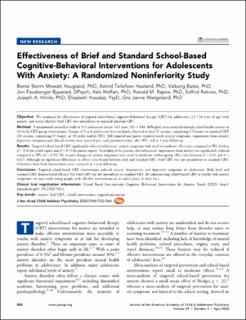| dc.contributor.author | Haugland, Bente Storm Mowatt | |
| dc.contributor.author | Haaland, Åshild Tellefsen | |
| dc.contributor.author | Baste, Valborg | |
| dc.contributor.author | Bjaastad, Jon Fauskanger | |
| dc.contributor.author | Hoffart, Asle | |
| dc.contributor.author | Rapee, Ronald M. | |
| dc.contributor.author | Raknes, Solfrid | |
| dc.contributor.author | Himle, Joseph A. | |
| dc.contributor.author | Husabo, Elisabeth | |
| dc.contributor.author | Wergeland, Gro Janne | |
| dc.date.accessioned | 2021-04-21T08:58:34Z | |
| dc.date.available | 2021-04-21T08:58:34Z | |
| dc.date.created | 2020-05-04T20:50:57Z | |
| dc.date.issued | 2020 | |
| dc.Published | Journal of the American Academy of Child and Adolescent Psychiatry. 2020, 59 (4), 552-564. | |
| dc.identifier.issn | 0890-8567 | |
| dc.identifier.uri | https://hdl.handle.net/11250/2738806 | |
| dc.description.abstract | Objective
We examined the effectiveness of targeted school-based cognitive-behavioral therapy (CBT) for adolescents (12−16 years of age) with anxiety, and tested whether brief CBT was noninferior to standard duration CBT.
Method
A randomized controlled study of 313 adolescents (mean 14.0 years, SD = 0.84, 84% girls) were recruited through school health services to 10 weeks CBT group interventions. Groups of 5 to 8 adolescents were randomly allocated to brief (5 sessions, comprising 5.5 hours) or standard CBT (10 sessions, comprising 15 hours), or 10 weeks waitlist (WL). Self-reported and parent-reported youth anxiety symptoms, impairment from anxiety, depressive symptoms,and clinical severity were assessed pre- and postintervention, after WL, and at 1-year follow-up.
Results
Targeted school based CBT significantly reduced adolescents’ anxiety symptoms with small to moderate effect sizes compared to WL (Cohen d = 0.34 for youth report and d = 0.53 for parent report). According to the parents, also adolescents’ impairment from anxiety was significantly reduced compared to WL (d = 0.51). Pre to post changes in anxiety symptoms were small to moderate (within-group effect sizes between d = 0.41 and d = 0.67). Although no significant differences in effects were found between brief and standard CBT, brief CBT was not noninferior to standard CBT. Outcomes from both interventions were sustained at 1-year follow-up.
Conclusion
Targeted school-based CBT interventions reduced anxiety, impairment, and depressive symptoms in adolescents. Both brief and standard CBT demonstrated efficacy, but brief CBT was not noninferior to standard CBT. By administering school-based CBT to youths with anxiety symptoms, we may reach young people with effective interventions at an earlier phase in their lives. | en_US |
| dc.language.iso | eng | en_US |
| dc.publisher | Elsevier | en_US |
| dc.rights | Attribution-NonCommercial-NoDerivatives 4.0 Internasjonal | * |
| dc.rights.uri | http://creativecommons.org/licenses/by-nc-nd/4.0/deed.no | * |
| dc.title | Effectiveness of Brief and Standard School-Based Cognitive-Behavioral Interventions for Adolescents With Anxiety: A Randomized Noninferiority Study | en_US |
| dc.type | Journal article | en_US |
| dc.type | Peer reviewed | en_US |
| dc.description.version | publishedVersion | en_US |
| dc.rights.holder | Copyright 2020 The Authors | en_US |
| cristin.ispublished | true | |
| cristin.fulltext | original | |
| cristin.qualitycode | 2 | |
| dc.identifier.doi | 10.1016/j.jaac.2019.12.003 | |
| dc.identifier.cristin | 1809305 | |
| dc.source.journal | Journal of the American Academy of Child and Adolescent Psychiatry | en_US |
| dc.source.40 | 59 | |
| dc.source.14 | 4 | |
| dc.source.pagenumber | 552-564 | en_US |
| dc.identifier.citation | Journal of the American Academy of Child and Adolescent Psychiatry. 2020, 59 (4), 552-564 | en_US |
| dc.source.volume | 59 | en_US |
| dc.source.issue | 4 | en_US |

